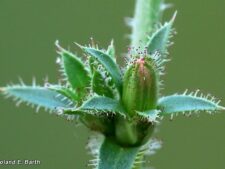
This weedy perennial plant, a native of Eurasia, is commonly found along roadways, usually growing erect up to about 3 feet tall. Basal leaves are deeply divided but the clasping, alternate stem leaves are oblong to lance-shaped with toothed or smooth margins. Bright blue dandelion-like flowers are about 2 inches across when open (A). From 12-20 narrow strap-like petals have 5 fine teeth at the tip. In the center, deep blue anthers are fused around the pistil whose tip divides into 2 blue styles (A). Leaf-like bracts (just below the flower) have glandular hairs on their edges with bright red glands (B). Hairs are also found along stems and the main nerve on the underside of the leaves (C). The tiny, ribbed seed has small scales, but no fluffy hairs at the tip. Chicory has a prominent, stout taproot.
This plant was first noticed, identified and photographed on Cottonwood Trail on the Fontenelle Forest flood plain in August 2013. It competed with other post-flood (2011) weedy species to grow much taller than normal, as did most of the other weeds there. It has not been seen recently nor has it been found at Neale Woods. Considering its abundance in the local area it would not be surprising if this opportunist reappeared on a Nature Center roadside or other area of disturbance in the future, but for now it seems to have disappeared.
Flowering occurs from June to October.
Flowers are very similar to Blue Lettuce , Mulgedium pulchellum, a species that has been seen at Neale Woods. Chicory is generally taller and has larger flowers on less widely branched stems. Also, Blue Lettuce seeds have attached fluffy, white hairs. If the seed heads have white hairs, it is not Chicory.
Chicory roots have a long history of use as a supplement or substitute for coffee. They also contain the carbohydrate inulin, used in medicine to measure kidney function and commercially as a nutritional supplement or sweetener.
There are many common names for Chicory including, Blue Daisy, Blue Sailors, Succory, Coffeeweed and Cornflower.
The content of NatureSearch is provided by dedicated volunteer Naturalists of Fontenelle Forest who strive to provide the most accurate information available. Contributors of the images retain their copyrights. The point of contact for this page is: Roland Barth.

 Identification
Identification
